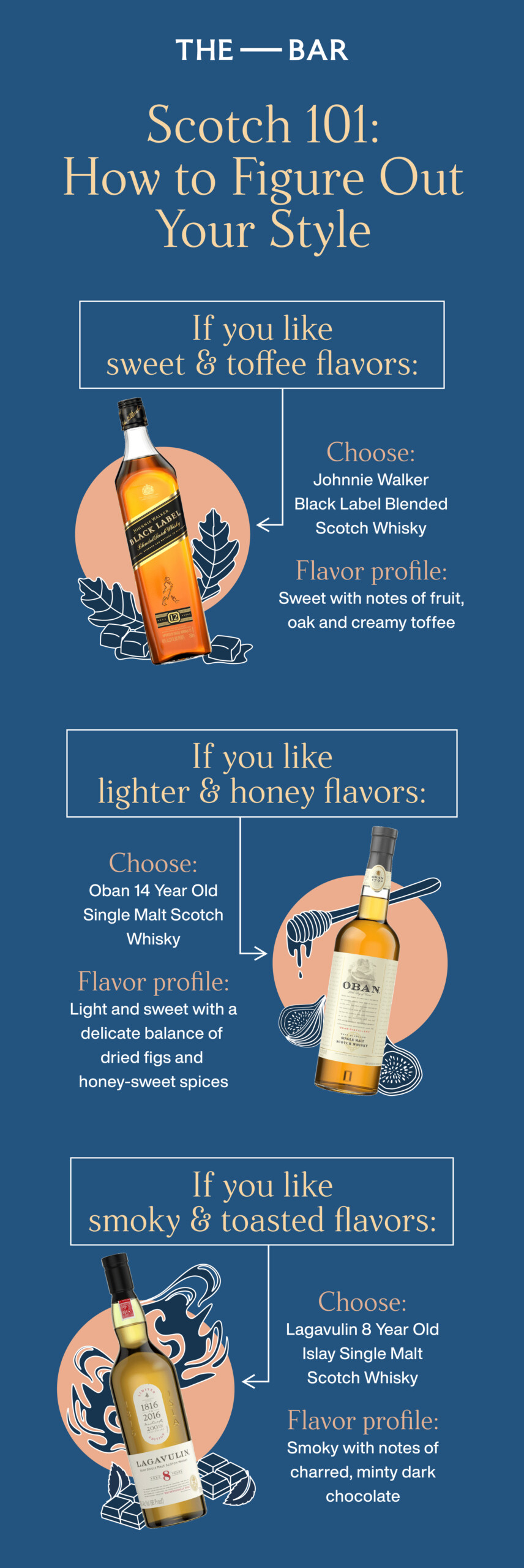![Scotch 101: How to Figure Out Your Style [Infographic]](http://vinepair.com/wp-content/themes/vpcontent/images/blank.gif)
For those who are unfamiliar, Scotch whisky can be a little intimidating. Don’t be scared, be curious! Whether you are a first-time buyer or a connoisseur, read on and let us be your spirit guide on all things Scotch.
What is Scotch?
Malted barley is the basic building block of Scotch. But to be Scotch, a spirit must meet the checklist of regulations passed by the U.K. parliament in 2009:
- It must be distilled in Scotland from water, malted barley, and other whole cereal grains.
- It must be aged in oak casks for a minimum of three years.
- It must be bottled at no less than 40 percent ABV.
While Scotch whisky shares some similarities with its American and Irish cousins, it’s made distinct by its place of origin, regulation and even spelling.
Is Scotch “Whisky” or “Whiskey”?
Did you know? Scotch whisky is whisky without the “e” — always. The word comes from the Gaelic usquebaugh, or “water of life,” but which the Irish spelled “whiskey” for their homegrown equivalent.
While Scotch whiskey in America was typically spelled “whisky” early on, they later adopted the Irish spelling, but there is more to set American and Scotch whiskeys/whiskies apart than just the spelling. America’s most famous whiskey variations — bourbon and rye — are distilled from a majority of corn or rye, rather than malt.
The 5 Types of Scotch
By law, Scotch is divided into five classifications:
- Single malt Scotch whisky: Made at a single distillery exclusively from malted barley, like Talisker 10 Year Old Single Malt Scotch Whisky.
- Single grain Scotch whisky: Made at a single distillery from malted barley and one additional whole grain, such as wheat or rye, like Orphan Barrel Muckety-Muck 25 Year Old Single Grain Scotch Whisky.
- Blended malt Scotch whisky: Made by blending two or more single malts, like Copper Dog Speyside Blended Malt Scotch Whisky.
- Blended grain Scotch whisky: Made by blending two or more single grains.
- Blended Scotch whisky: Made by blending one or more single malts and single grains, like Johnnie Walker Black Label Blended Scotch Whisky.
It’s a Matter of Personal Taste
It’s not as simple as “older is better.” Whether you prefer a younger or more mature Scotch is simply a matter of personal taste, but there are a few things to consider:
- Age Statement: The numerals that sometimes appear after a scotch’s name are its “age statement” indicating the number of years that the spirit has been aged in oak.
- Flavor Profile: The increased time in oak will generally make its flavor profile more complex and add more body.
- Region: Scotland is divided into five whisky-making regions: Speyside, Campbeltown, Highland, Lowland, and Islay. This can change up the flavor. Whiskies made from the Speyside region are known for being fruit-forward and only mildly smoky, while those from the Islay region have a reputation for being heavily peated and presenting smoky, medicinal flavors.
- Price: Because a small percentage of the whisky will evaporate each year during the aging process (this lost liquid is referred to as the “angel’s share”), and the fact that holding inventory costs money, the price of Scotch often increases with its age.
Scotches to Get Started With for Beginners
So… when it comes to picking your Scotch, it really all comes down to your flavor preference.
- Fruit & Toffee Flavor: An excellent starting point and a tasty introduction to the world of blended Scotch whisky is Johnnie Walker Black Label Blended Scotch Whisky. As a blended Scotch whisky that is 1) composed of single malts and single grains 2) aged at least 12 years, this product highlights Scotch’s typical notes of fruit and creamy toffee coupled with light smoke.
- Light & Sweet Flavor: If you wish to experience an older Scotch that is on the lighter and sweeter side, you may want to spring for Oban 14 Year Old Single Malt Scotch Whisky.
- Smoky Flavor: Experiment with Lagavulin 8 Year Old Islay Single Malt Scotch Whisky if the smoky flavors of a peated Islay scotch sound appealing to you.
This infographic is sponsored by The Bar.
![Whether you are a first time buyer or a connoisseur, read on and let us be your spirit guide on all things scotch. Scotch 101: How to Figure Out Your Style [Infographic]](https://vinepair.com/wp-content/uploads/2022/12/thebar-infographic3-v3-card-1.jpg)
